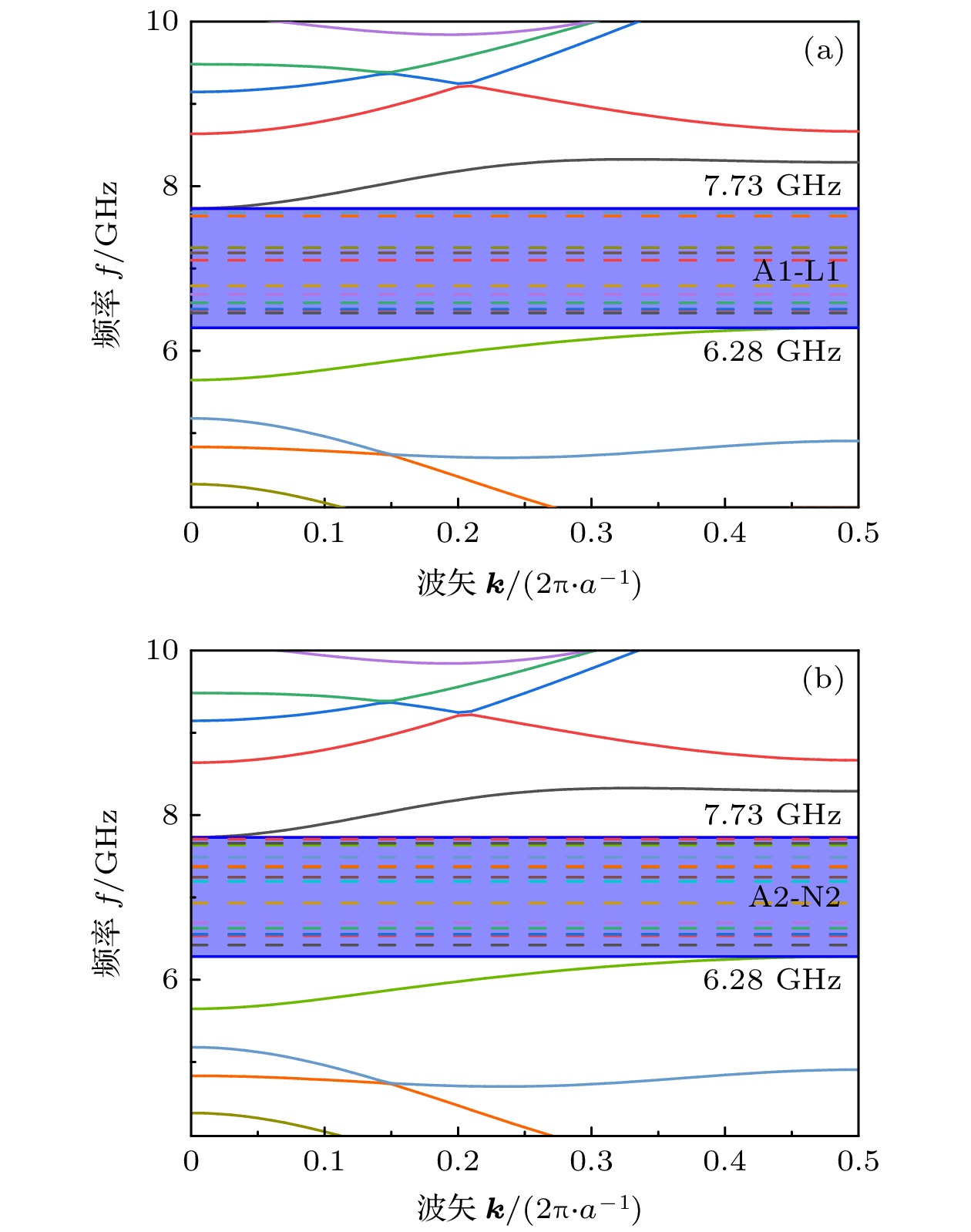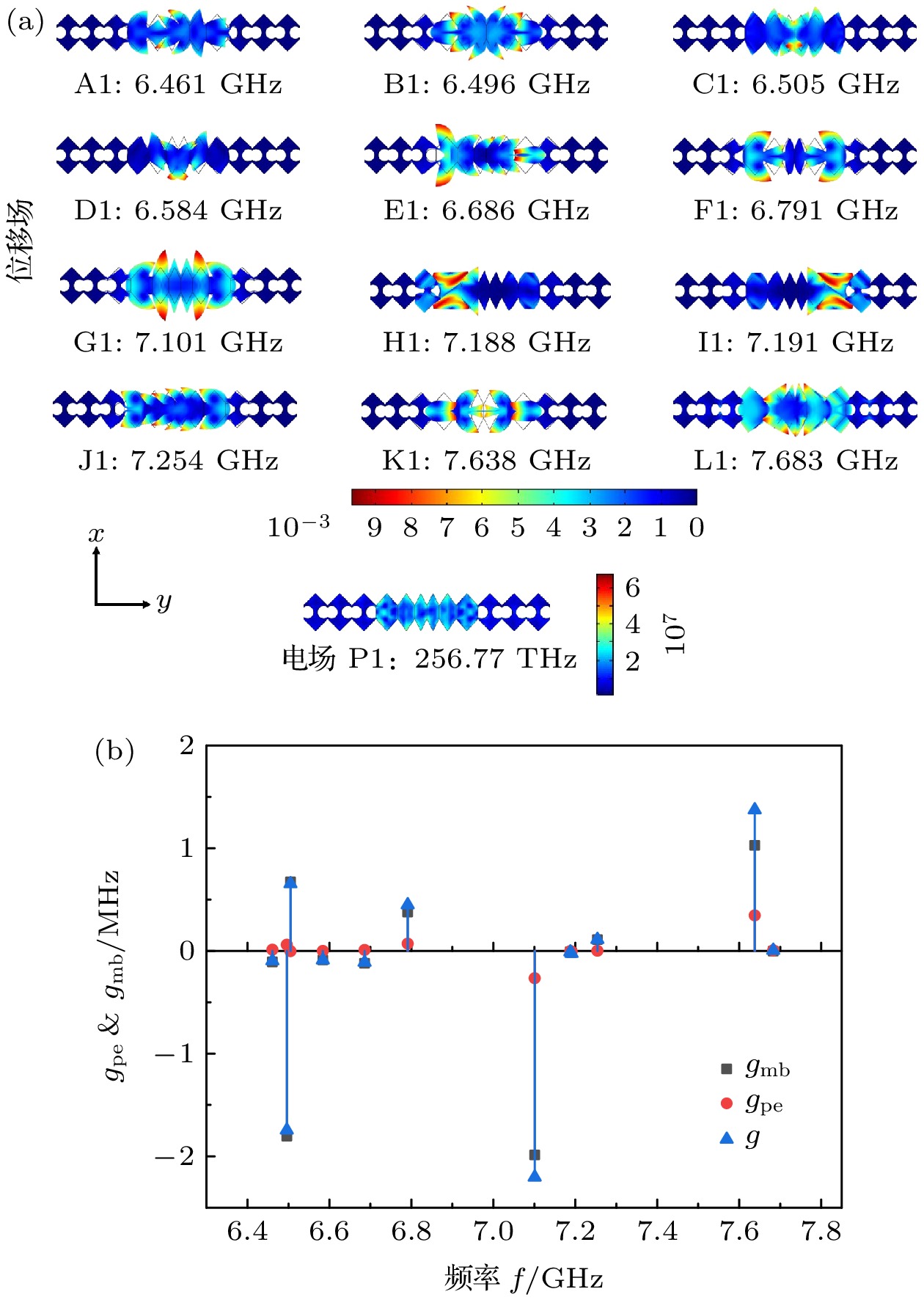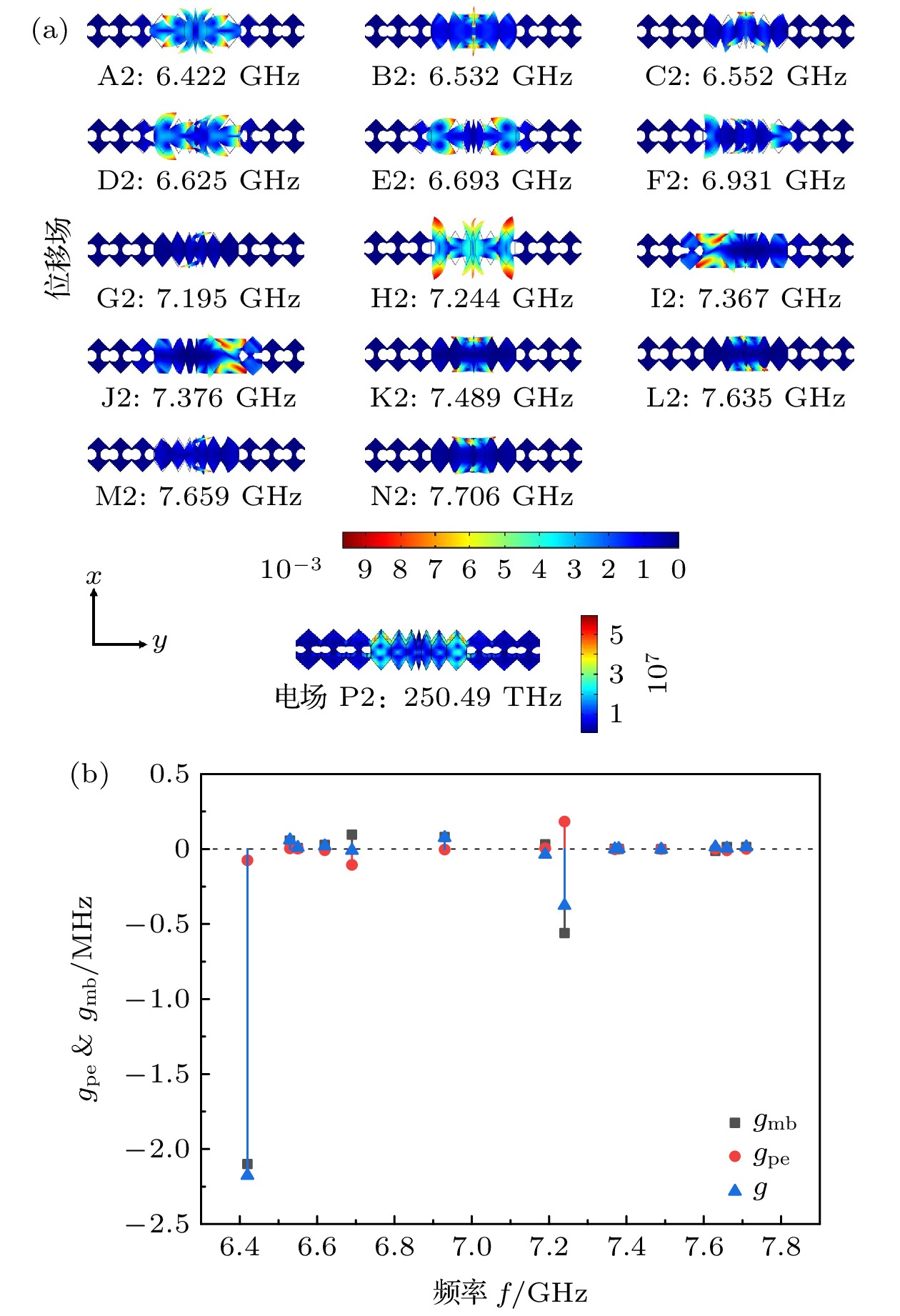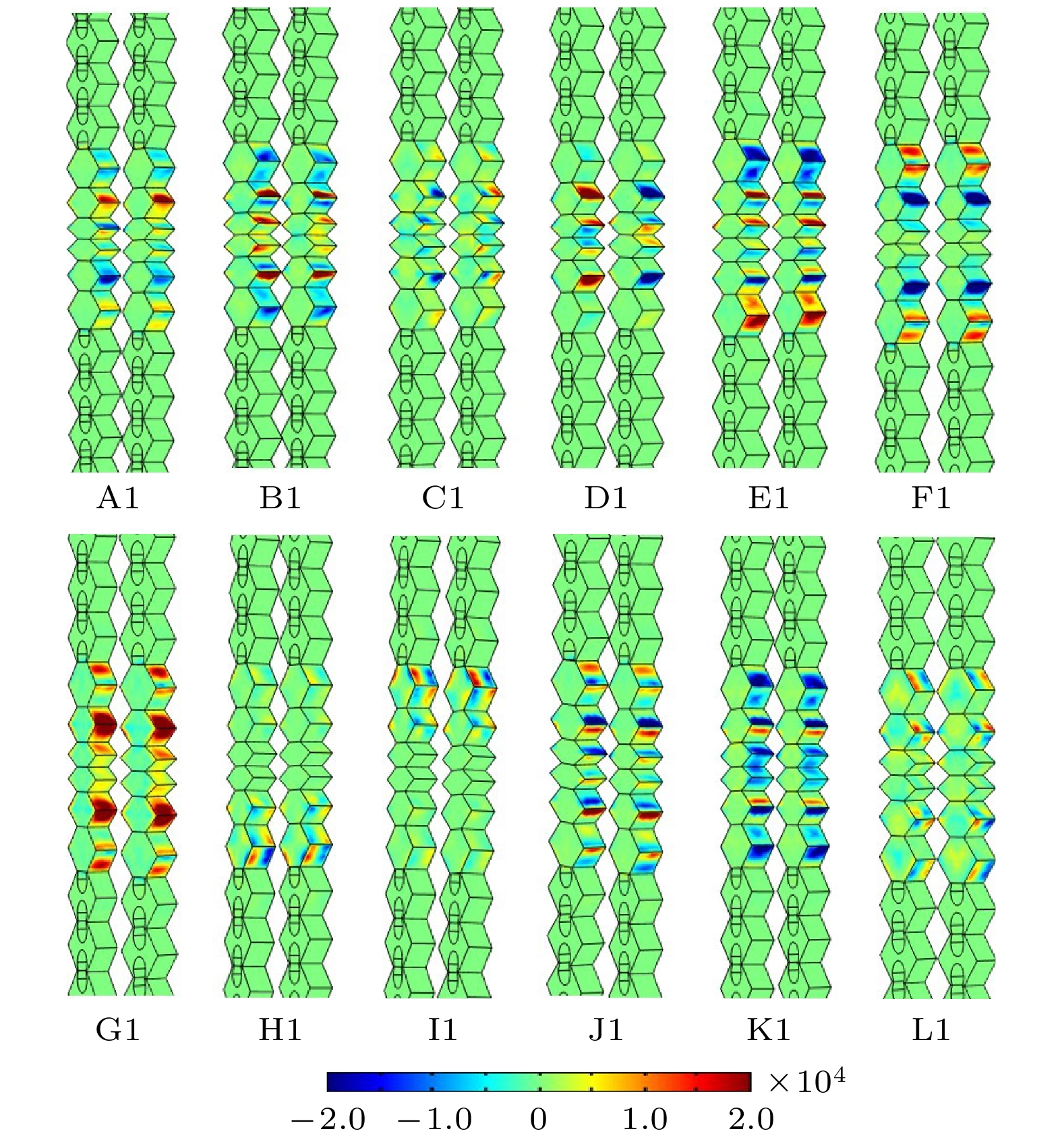-
本文设计了一种由两侧挖孔的六棱柱单胞周期性排列而成的新型光力晶体纳米梁谐振腔, 利用有限元法计算了该结构在不同缺陷态下的带隙特性. 基于移动边界效应和光弹性效应机制, 采用一阶微扰理论并借助光力耦合系数计算法获得了光力晶体纳米梁谐振腔的光力耦合率, 同时分析了谐振腔声学模态的对称性, 并对光力耦合机制进行了探索. 研究表明: 改变缺陷数量或优化几何结构均可改善光学模式和机械模式的重叠性; 对于同种缺陷不同数量的谐振腔结构, 缺陷数量只会影响光力耦合率中移动边界效应和光弹性效应的作用方式, 而几乎不会改变其耦合率的大小. 分析具有梯度缺陷的光力晶体纳米梁谐振腔的振动模态对称性发现, 只有关于x-y, x-z, y-z平面偶对称的振动模态才能与光学模态产生强耦合, 并得到高达2.25 MHz的光力耦合率.Optomechanical crystals can simultaneously modulate elastic waves and electromagnetic waves as well as localizing phonons and photons to enhance the acousto-optic interaction. In this work, a new type of optomechanical crystal nanobeam cavity is designed by periodically arranging the unit cells with double holes on both sides of a hexagonal prism. Considering the moving boundary effect and the photoelastic effect as well as using the first-order electromagnetic perturbation theory and the optomechanical coupling coefficient calculation method, the optomechanical coupling rate of the structure is calculated. The result shows that the overlap between the optical mode and the mechanical mode can be improved by changing the number of defects and optimizing the geometric structure. For the nanobeam cavity structures with different numbers of the like defects, the number of defects will only affect the action mode of the moving boundary effect and photoelastic effect in the optomechanical coupling rate, but will not change the coupling rate too much. In particular, the optomechanical coupling rate of the single defect optomechanical crystal nanobeam cavity can reach –1.29 MHz, and the equivalent mass is 42.6 fg. Moreover, the designed structure is simple and easy to process and fabricate. The coupling rate of even-symmetric optomechanical crystal nanobeam cavity based on gradient defect can reach 2.25 MHz, and the coupling rate of odd symmetric structure can reach 2.18 MHz, in which the moving boundary effect is dominant. Based on the symmetry analysis of the vibration modes of the optomechanical crystal nanobeam cavity with gradient defects, it is worth noting that only the even symmetrical vibration modes of x-y, x-z and y-z can strongly couple with the optical modes. The surface density of the moving boundary effect is calculated and analyzed, and it is found that the surface density of the acoustic resonance mode with high symmetry also possesses high symmetry. However, when the surface density of the moving boundary effect in the defect state appears adjacent to each other and cancels out each other, it will destroy the coupling mode of the moving boundary effect and reduce the coupling rate, whether the symmetry is high or low. In addition, the designed optomechanical crystal nanobeam can also improve the quality factor of the resonant cavity by optimizing the defect structure while maintaining a high optomechanical coupling rate. Therefore, this research provides an effective means to find a structure with high optomechanical coupling rate, and also presents the ideas for designing the space sensors.
[1] John S 1987 Phys. Rev. Lett. 58 2486
 Google Scholar
Google Scholar
[2] 张若羽, 李培丽 2021 物理学报 70 054208
 Google Scholar
Google Scholar
Zhang R Y, Li P L 2021 Acta Phys. Sin. 70 054208
 Google Scholar
Google Scholar
[3] Kushwaha M S, Halevi P, Dobrzynski L, Djafari-Rouhani B 1993 Phys. Rev. Lett. 71 2022
 Google Scholar
Google Scholar
[4] Pennec Y, Laude V, Papanikolaou N, Djafari-Rouhani B, Oudich M, El Jallal S, Beugnot J C, Escalante J M, Martínez A 2014 Nanophotonics 3 413
 Google Scholar
Google Scholar
[5] Maldovan M, Thomas E L 2006 Appl. Phys. Lett. 88 251907
 Google Scholar
Google Scholar
[6] Moradi P, Bahrami A 2018 J. Appl. Phys. 123 115113
 Google Scholar
Google Scholar
[7] Yu Z, Sun X 2018 Opt. Express 26 1255
 Google Scholar
Google Scholar
[8] Li H, Liu W, Yu T, Wang T, Liao Q 2020 Phys. Lett. A 384 126499
 Google Scholar
Google Scholar
[9] Shu Y, Yu M, Yu T, Liu W, Wang T, Liao Q 2020 Opt. Express 28 24813
 Google Scholar
Google Scholar
[10] Shaban S M, Mehaney A, Aly A H 2020 Appl. Optics 59 3878
 Google Scholar
Google Scholar
[11] Lucklum R, Zubtsov M, Oseev A 2013 Anal. Bioanal. Chem. 405 6497
 Google Scholar
Google Scholar
[12] Eichenfield M, Camacho R, Chan J, Vahala K J, Painter O 2009 Nature 459 550
 Google Scholar
Google Scholar
[13] Eichenfield M, Chan J, Camacho R M, Vahala K J, Painter O 2009 Nature 462 78
 Google Scholar
Google Scholar
[14] 陈华俊, 方贤文, 陈昌兆, 李洋 2016 物理学报 65 194205
 Google Scholar
Google Scholar
Chen H J, Fang X W, Chen C Z, Li Y 2016 Acta Phys. Sin. 65 194205
 Google Scholar
Google Scholar
[15] 罗均文, 吴德伟, 苗强, 魏天丽 2020 物理学报 69 054203
 Google Scholar
Google Scholar
Luo J W, Wu D W, Miao Q, Wei T L 2020 Acta Phys. Sin. 69 054203
 Google Scholar
Google Scholar
[16] Chan J, Alegre T P, Safavi-Naeini A H, Hill J T, Krause A, Groblacher S, Aspelmeyer M, Painter O 2011 Nature 478 89
 Google Scholar
Google Scholar
[17] Safavi-Naeini A H, Van Thourhout D, Baets R, van Laer R 2019 Optica 6 213
 Google Scholar
Google Scholar
[18] Liu Q, Lu H, Bibbó L, Wang Q, Lin M, Tao K, Albin S, Ouyang Z 2020 Appl. Nanosci. 10 1395
 Google Scholar
Google Scholar
[19] Ramp H, Clark T, Hauer B, Doolin C, Balram KC, Srinivasan K, Davis J 2020 Appl. Phys. Lett. 116 174005
 Google Scholar
Google Scholar
[20] Ren H, Matheny M H, MacCabe G S, Luo J, Pfeifer H, Mirhosseini M, Painter O 2020 Nat. Commun. 11 3373
 Google Scholar
Google Scholar
[21] Rolland Q, Oudich M, El-Jallal S, Dupont S, Pennec Y, Gazalet J, Kastelik J C, Lévêque G, Djafari-Rouhani B 2012 Appl. Phys. Lett. 101 061109
 Google Scholar
Google Scholar
[22] Chan J, Safavi-Naeini AH, Hill J T, Meenehan S, Painter O 2012 Appl. Phys. Lett. 101 081115
 Google Scholar
Google Scholar
[23] Gomis-Bresco J, Navarro-Urrios D, Oudich M, El-Jallal S, Griol A, Puerto D, Chavez E, Pennec Y, Djafari-Rouhani B, Alzina F, Martinez A, Torres C M 2014 Nat. Commun. 5 4452
 Google Scholar
Google Scholar
[24] Oudich M, El-Jallal S, Pennec Y, Djafari-Rouhani B, Gomis-Bresco J, Navarro-Urrios D, Sotomayor Torres C M, Martínez A, Makhoute A 2014 Phys. Rev. B 89 245122
 Google Scholar
Google Scholar
[25] Li Y, Cui K, Feng X, Huang Y, Huang Z, Liu F, Zhang W 2015 Journal of Optics 17 045001
 Google Scholar
Google Scholar
[26] Chiu C C, Chen W M, Sung K W, Hsiao F L 2017 Opt. Express 25 6076
 Google Scholar
Google Scholar
[27] Lin T R, Chang C C, Hsu J C 2019 J. Appl. Phys. 126 064901
 Google Scholar
Google Scholar
[28] Huang N N, Chung Y C, Chiu H T, Hsu J C, Lin Y F, Kuo C T, Chang Y W, Chen C Y, Lin T R 2020 Crystals 10 421
 Google Scholar
Google Scholar
[29] Pennec Y, Rouhani B D, Li C, Escalante J M, Martinez A, Benchabane S, Laude V, Papanikolaou N 2011 AIP Adv. 1 041901
 Google Scholar
Google Scholar
[30] Hsu J C, Lu T Y, Lin T R 2015 Opt. Express 23 25814
 Google Scholar
Google Scholar
[31] Aram M, Khorasani S 2017 Appl. Phys. B-Lasers O. 123 218
 Google Scholar
Google Scholar
[32] Johnson S G, Ibanescu M, Skorobogatiy M A, Weisberg O, Joannopoulos J D, Fink Y 2002 Phys. Rev. E 65 066611
 Google Scholar
Google Scholar
[33] Eichenfield M, Chan J, Safavi-Naeini AH, Vahala KJ, Painter O 2009 Opt. Express 17 20078
 Google Scholar
Google Scholar
-
图 1 所设计的一维六角双孔型光力晶体纳米梁谐振腔: (a)谐振腔结构; (b)光力晶体单胞; (c)不同缺陷数量谐振腔; (d)偶对称型梯度谐振腔; (e)奇对称型梯度谐振腔
Fig. 1. The model structures of the one-dimensional hexagonal double-hole type optomechanical crystal nanobeam cavity designed in the present work, where (a) is nanobeam cavity structure, (b) is optomechanical crystal unit cell, (c) represents the cavity with different number of defects, and (d) and (e) are the even-symmetric and odd-symmetric gradient nanobeam cavity, respectively.
图 2 六角双孔型光力晶体能带结构: (a)声子能带结构; (b)光子能带结构; (c)声子带隙随内孔半径的改变; (d)光子带隙随内孔半径的改变; (e)无缺陷纳米梁与奇对称型谐振腔声透射谱; (f)无缺陷纳米梁与偶对称型谐振腔声透射谱
Fig. 2. The band structures of hexagonal double-hole type optomechanical crystal, where (a) and (b) represent the phononic and photonic band structure, respectively, (c) and (d) correspond to the change of the phononic and photonic band gap with the radius of the inner hole, and (e) and (f) are different defects acoustic transmission spectrum of optomechanical crystal nanobeam cavity.
图 5 几何优化谐振腔的声子能带结构: (a)偶对称谐振腔的声子能带结构, A1-L1为带隙内产生的声子缺陷模; (b)奇对称谐振腔的声子能带结构, A2-N2为带隙内产生的声子缺陷模
Fig. 5. Phononic band structures of the geometrically optimized nanobeam cavities, where (a) is phononic band structure of the even symmetric cavity, in which A1-L1 are the defect modes generated in phononic band gap, and (b) is phononic band structure of the odd symmetric cavity, in which A2-N2 are the defect modes generated in phononic band gap.
图 6 几何优化偶对称谐振腔的电场和位移场模态及其光力耦合率: (a)谐振腔的位移场模态图A1-L1与电场模态图P1; (b)光力耦合率及其分量gmb和gpe
Fig. 6. Geometrically optimize the electric field and displacement field modes of the even symmetric nanobeam cavity and optomechanical coupling rates, where (a) represents displacement field mode diagram A1-L1 and electric field mode diagram P1 of the nanobeam cavity, and (b) is optomechanical coupling rates of nanobeam cavities and its components gmb and gpe.
图 7 几何优化奇对称谐振腔的电场和位移场模态及其光力耦合率: (a)奇数谐振腔的位移场模态图A2-N2与电场模态图P2; (b)光力耦合率及其分量gmb和gpe
Fig. 7. Geometrically optimize the electric field and displacement field modes of the odd symmetric nanobeam cavity and optomechanical coupling rates, where (a) represents displacement field mode diagram A2-N2 and electric field mode diagram P2 of the nanobeam cavity, and (b) is optomechanical coupling rates of nanobeam cavity and its components gmb and gpe.
表 1 偶对称型谐振腔声学共振模式与光学模式的耦合率
Table 1. Optomechanical coupling rates of even symmetric nanobeam cavity
A1 B1 C1 D1 E1 F1 gmb / Hz –1.076×105 –1.805×106 6.721×105 –8.925×104 –1.204×105 3.790×105 gpe / Hz 1.130×104 6.104×104 –1.888×103 6.130×102 9.662×103 7.078×104 g0 / Hz –9.626×104 –1.744×106 6.532×105 –8.864×104 –1.108×105 4.498×105 meff / 10–17 kg 2.429 4.072 1.657 1.719 6.816 4.698 G1 H1 I1 J1 K1 L1 gmb / Hz –1.987×106 –9.336×103 –1.745×104 1.102×105 1.028×106 –2.258×103 gpe / Hz –2.661×105 –1.470×103 –6.952×103 1.425×103 3.462×105 7.341×103 g0 / Hz –2.253×106 –1.081×104 –2.440×104 1.116×105 1.374×106 5.083×103 meff / 10–17 kg 7.086 2.879 2.949 3.320 8.115 3.701 表 2 奇对称型谐振腔声学共振模式与光学模式的耦合率
Table 2. Optomechanical coupling rates of odd symmetric nanobeam cavity
A2 B2 C2 D2 E2 F2 G2 gmb/Hz –2.100×106 5.629×104 7.079×103 2.795×104 9.599×104 8.016×104 3.082×104 gpe/Hz –7.580×104 4.084×103 2.762×103 –8.579×103 –1.062×105 –4.091×103 5.240×103 g0/Hz –2.176×106 6.037×104 9.840×103 1.937×104 –1.024×104 7.607×104 –3.606×104 meff /10–17 kg 3.28 0.991 1.05 3.65 2.79 1.41 0.110 H2 I2 J2 K2 L2 M2 N2 gmb/Hz –5.600×105 1.818×103 6.875×102 –1.391×103 –1.240×104 1.401×104 1.311×104 gpe/Hz 1.833×105 –2.254×103 1.972×103 –3.701×102 2.550×102 –8.942×103 9.903×102 g0/Hz –3.767×105 –4.357×102 2.659×103 –1.761×103 1.266×104 5.066×103 1.410×104 meff /10–17 kg 9.16 1.96 1.89 0.296 0.233 0.287 0.260 表 3 新型梯度腔光力晶体梁的光力耦合率
Table 3. Optomechanical coupling rates of a new gradient cavity optomechanical crystal nanobeam.
f/GHz gmb/Hz gpe/Hz g0/Hz meff /kg 7.545 –1.093×105 –2.076×106 –2.185×106 7.383×10–17 -
[1] John S 1987 Phys. Rev. Lett. 58 2486
 Google Scholar
Google Scholar
[2] 张若羽, 李培丽 2021 物理学报 70 054208
 Google Scholar
Google Scholar
Zhang R Y, Li P L 2021 Acta Phys. Sin. 70 054208
 Google Scholar
Google Scholar
[3] Kushwaha M S, Halevi P, Dobrzynski L, Djafari-Rouhani B 1993 Phys. Rev. Lett. 71 2022
 Google Scholar
Google Scholar
[4] Pennec Y, Laude V, Papanikolaou N, Djafari-Rouhani B, Oudich M, El Jallal S, Beugnot J C, Escalante J M, Martínez A 2014 Nanophotonics 3 413
 Google Scholar
Google Scholar
[5] Maldovan M, Thomas E L 2006 Appl. Phys. Lett. 88 251907
 Google Scholar
Google Scholar
[6] Moradi P, Bahrami A 2018 J. Appl. Phys. 123 115113
 Google Scholar
Google Scholar
[7] Yu Z, Sun X 2018 Opt. Express 26 1255
 Google Scholar
Google Scholar
[8] Li H, Liu W, Yu T, Wang T, Liao Q 2020 Phys. Lett. A 384 126499
 Google Scholar
Google Scholar
[9] Shu Y, Yu M, Yu T, Liu W, Wang T, Liao Q 2020 Opt. Express 28 24813
 Google Scholar
Google Scholar
[10] Shaban S M, Mehaney A, Aly A H 2020 Appl. Optics 59 3878
 Google Scholar
Google Scholar
[11] Lucklum R, Zubtsov M, Oseev A 2013 Anal. Bioanal. Chem. 405 6497
 Google Scholar
Google Scholar
[12] Eichenfield M, Camacho R, Chan J, Vahala K J, Painter O 2009 Nature 459 550
 Google Scholar
Google Scholar
[13] Eichenfield M, Chan J, Camacho R M, Vahala K J, Painter O 2009 Nature 462 78
 Google Scholar
Google Scholar
[14] 陈华俊, 方贤文, 陈昌兆, 李洋 2016 物理学报 65 194205
 Google Scholar
Google Scholar
Chen H J, Fang X W, Chen C Z, Li Y 2016 Acta Phys. Sin. 65 194205
 Google Scholar
Google Scholar
[15] 罗均文, 吴德伟, 苗强, 魏天丽 2020 物理学报 69 054203
 Google Scholar
Google Scholar
Luo J W, Wu D W, Miao Q, Wei T L 2020 Acta Phys. Sin. 69 054203
 Google Scholar
Google Scholar
[16] Chan J, Alegre T P, Safavi-Naeini A H, Hill J T, Krause A, Groblacher S, Aspelmeyer M, Painter O 2011 Nature 478 89
 Google Scholar
Google Scholar
[17] Safavi-Naeini A H, Van Thourhout D, Baets R, van Laer R 2019 Optica 6 213
 Google Scholar
Google Scholar
[18] Liu Q, Lu H, Bibbó L, Wang Q, Lin M, Tao K, Albin S, Ouyang Z 2020 Appl. Nanosci. 10 1395
 Google Scholar
Google Scholar
[19] Ramp H, Clark T, Hauer B, Doolin C, Balram KC, Srinivasan K, Davis J 2020 Appl. Phys. Lett. 116 174005
 Google Scholar
Google Scholar
[20] Ren H, Matheny M H, MacCabe G S, Luo J, Pfeifer H, Mirhosseini M, Painter O 2020 Nat. Commun. 11 3373
 Google Scholar
Google Scholar
[21] Rolland Q, Oudich M, El-Jallal S, Dupont S, Pennec Y, Gazalet J, Kastelik J C, Lévêque G, Djafari-Rouhani B 2012 Appl. Phys. Lett. 101 061109
 Google Scholar
Google Scholar
[22] Chan J, Safavi-Naeini AH, Hill J T, Meenehan S, Painter O 2012 Appl. Phys. Lett. 101 081115
 Google Scholar
Google Scholar
[23] Gomis-Bresco J, Navarro-Urrios D, Oudich M, El-Jallal S, Griol A, Puerto D, Chavez E, Pennec Y, Djafari-Rouhani B, Alzina F, Martinez A, Torres C M 2014 Nat. Commun. 5 4452
 Google Scholar
Google Scholar
[24] Oudich M, El-Jallal S, Pennec Y, Djafari-Rouhani B, Gomis-Bresco J, Navarro-Urrios D, Sotomayor Torres C M, Martínez A, Makhoute A 2014 Phys. Rev. B 89 245122
 Google Scholar
Google Scholar
[25] Li Y, Cui K, Feng X, Huang Y, Huang Z, Liu F, Zhang W 2015 Journal of Optics 17 045001
 Google Scholar
Google Scholar
[26] Chiu C C, Chen W M, Sung K W, Hsiao F L 2017 Opt. Express 25 6076
 Google Scholar
Google Scholar
[27] Lin T R, Chang C C, Hsu J C 2019 J. Appl. Phys. 126 064901
 Google Scholar
Google Scholar
[28] Huang N N, Chung Y C, Chiu H T, Hsu J C, Lin Y F, Kuo C T, Chang Y W, Chen C Y, Lin T R 2020 Crystals 10 421
 Google Scholar
Google Scholar
[29] Pennec Y, Rouhani B D, Li C, Escalante J M, Martinez A, Benchabane S, Laude V, Papanikolaou N 2011 AIP Adv. 1 041901
 Google Scholar
Google Scholar
[30] Hsu J C, Lu T Y, Lin T R 2015 Opt. Express 23 25814
 Google Scholar
Google Scholar
[31] Aram M, Khorasani S 2017 Appl. Phys. B-Lasers O. 123 218
 Google Scholar
Google Scholar
[32] Johnson S G, Ibanescu M, Skorobogatiy M A, Weisberg O, Joannopoulos J D, Fink Y 2002 Phys. Rev. E 65 066611
 Google Scholar
Google Scholar
[33] Eichenfield M, Chan J, Safavi-Naeini AH, Vahala KJ, Painter O 2009 Opt. Express 17 20078
 Google Scholar
Google Scholar
计量
- 文章访问数: 7397
- PDF下载量: 96
- 被引次数: 0













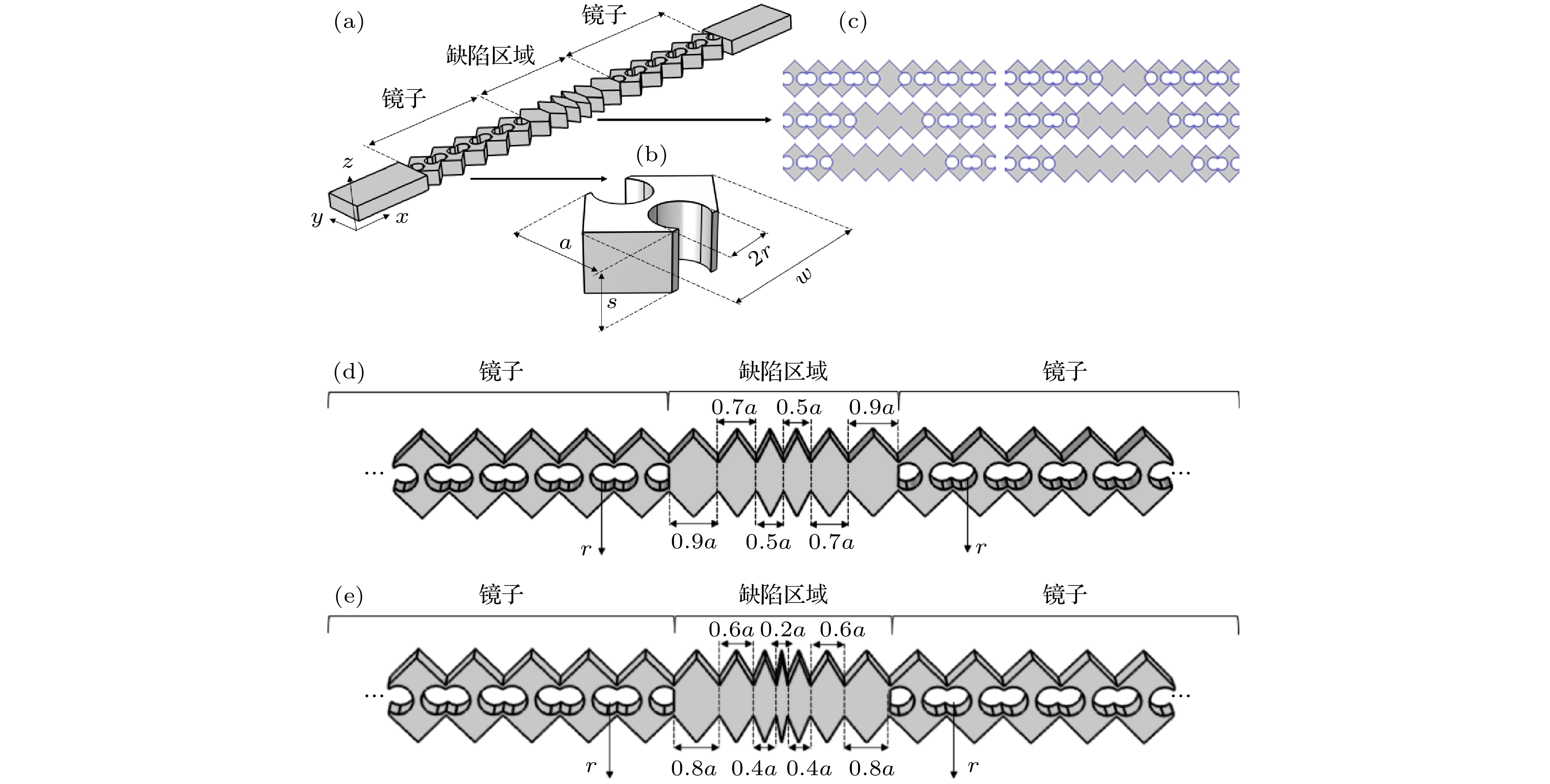
 下载:
下载:



